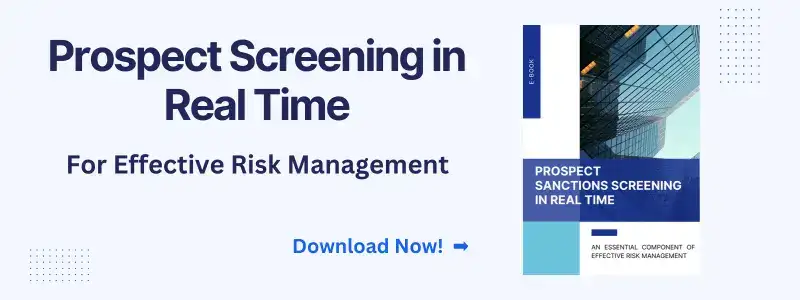In today's fast-paced and globalized financial landscape, prospect screening has become essential to every financial institution's risk management strategy. Ensuring that clients are screened thoroughly helps organizations comply with Anti-Money Laundering (AML) and Counter-Terrorist Financing (CTF) regulations and reduces the likelihood of becoming involved with high-risk individuals or entities that could harm their reputation and financial stability.
The digital age has revolutionized the way financial institutions conduct business, creating both opportunities and challenges for prospect screening. The shift towards online and digital financial services has accelerated the need for financial institutions to adapt their screening processes, as they now have access to vast amounts of data and must navigate an increasingly complex regulatory landscape. While digital advancements offer new tools and techniques for effective screening, they also introduce novel risks and potential vulnerabilities that must be addressed.
This blog aims to explore the challenges and opportunities that financial institutions face in the realm of prospect screening in the digital age. We will discuss the impact of technology, evolving regulations, and the changing nature of financial crime on screening processes. Additionally, we will highlight Tookitaki's innovative solutions designed to help financial institutions streamline and enhance their prospect screening practices in this dynamic environment.
Understanding Prospect Screening
Prospect screening is the process of evaluating potential clients or customers before establishing a business relationship with them. This process helps financial institutions and other businesses assess the risk associated with a particular client, ensuring that they comply with AML, CTF and other regulatory requirements.
Prospect screening involves conducting due diligence on potential clients by verifying their identity, checking their background, and evaluating their risk profile. This includes checking for any involvement in criminal activities, financial fraud, or connections to sanctioned individuals, organizations, or countries. The screening process may involve using various tools and databases, such as watchlists, sanction lists, and adverse media searches, to gather relevant information about the client.
By conducting thorough prospect screening, financial institutions can identify high-risk clients, prevent illicit activities, maintain compliance with relevant regulations, and safeguard their reputation and financial stability.
Challenges of Prospect Screening in the Digital Age
A. Evolving regulatory landscape
The ever-changing regulatory landscape presents a significant challenge for financial institutions in the digital age. As regulators worldwide continue to tighten AML and CTF requirements, financial institutions must constantly update their prospect screening processes to ensure compliance with new rules and guidelines. This necessitates ongoing monitoring of regulatory changes and the ability to adapt screening procedures quickly and efficiently.
B. Data privacy concerns
Data privacy is a growing concern in the digital age, as financial institutions have access to vast amounts of personal information about their clients. Ensuring the proper handling, storage, and sharing of sensitive data is crucial to maintaining client trust and adhering to data protection regulations. Financial institutions must strike a balance between conducting thorough prospect screening and respecting their clients' privacy rights.
C. Cross-border complexities
The globalization of finance has led to increased cross-border transactions and partnerships, introducing additional complexities to the prospect screening process. Financial institutions must navigate diverse legal and regulatory environments while screening clients from different countries, often requiring the use of multiple data sources and languages. This can lead to inconsistencies and inefficiencies in the screening process.
D. Resource constraints
Prospect screening can be a resource-intensive process, particularly for smaller financial institutions that may lack the personnel or technology to conduct thorough and efficient screenings. As regulatory requirements continue to evolve and expand, financial institutions must allocate more resources to prospect screening, potentially diverting them from other critical business functions.
E. New risks posed by emerging technologies
Emerging technologies, such as virtual assets, cryptocurrencies, and digital payment platforms, have introduced new risks and vulnerabilities to the financial system. Criminals are increasingly exploiting these technologies to facilitate money laundering and other illicit activities, making it more challenging for financial institutions to identify and mitigate risks during the prospect screening process. Staying ahead of these emerging threats requires continuous innovation and the adoption of new screening tools and techniques.
Opportunities for Financial Institutions
A. Leveraging AI and machine learning
The advent of AI and machine learning offers significant opportunities for financial institutions to enhance their prospect screening processes. These advanced technologies can automate various aspects of the screening process, helping organizations identify patterns, anomalies, and risks more effectively. By incorporating AI-driven analytics and risk assessment tools, financial institutions can streamline their screening efforts, reduce false positives, and increase the accuracy of their risk evaluations.
B. Enhanced due diligence with digital tools
Digital tools and data sources can significantly improve the efficiency and effectiveness of due diligence efforts. Financial institutions can access real-time information to make informed decisions about potential clients by leveraging comprehensive databases, watchlists, and adverse media searches. These tools can also help organizations stay up-to-date with the latest regulatory requirements and industry best practices, ensuring they maintain robust and compliant screening processes.
C. Streamlining the onboarding process
The use of digital technologies can help financial institutions expedite the onboarding process for new clients. By automating data collection, verification, and risk assessment tasks, organizations can reduce the time and effort required to onboard new clients, enhancing the overall customer experience. Streamlined onboarding can also help financial institutions grow their customer base by minimizing delays and frustrations often associated with traditional, manual screening processes.
D. Strengthening customer relationships through effective screening
Effective prospect screening can contribute to building stronger customer relationships by demonstrating a commitment to compliance, integrity, and security. By implementing robust screening processes, financial institutions can instill trust in their clients, ensuring that they are doing business with reputable partners. A proactive approach to risk management can also help organizations minimize potential reputational damage and financial losses resulting from associations with high-risk individuals or entities.
Tookitaki's Smart Screening Solution for Prospect Screening
Tookitaki's Anti-Money Laundering Suite (AMLS) is a groundbreaking, award-winning solution that modernises compliance processes for banks and fintechs. Among its three core modules, the Smart Screening module focuses on prospect, name, and transaction screening, helping financial institutions stay ahead of financial crime risks and meet regulatory requirements.
AI-driven risk assessment and customer profiling
Tookitaki's Prospect Screening solution leverages AI-powered fuzzy identity matching to enable real-time screening capabilities for prospect onboarding. It assesses risks and profiles customers by screening them against various watchlists, including the UN sanctions lists, PEP databases, and adverse media. This AI-driven approach streamlines the screening process, reduces false positives, and assists compliance specialists in various scenarios.
Key features and benefits of Tookitaki's Prospect Screening solution
Tookitaki's AMLS Prospect Screening solution offers several key features and benefits:
- Comprehensive watchlist coverage: The solution can screen against any number and kind of watchlists, both third-party and internal blacklists and whitelists.
- Hybrid two-pass matching approach: Combines statistical similarity and the common key method for higher precision and recall, resulting in fewer false positivesand false negatives.
- Full explainability: Provides complete transparency for each match, allowing financial institutions to understand and justify their screening decisions.
- API integration: Seamlessly integrates with existing systems, streamlining the onboarding process and reducing operational costs.
- Scalable and adaptable: Designed to grow with your organization and adapt to changing regulatory requirements and industry standards.
Adaptable to evolving regulations and industry standards
Tookitaki's AMLS Prospect Screening solution is built to adapt to the ever-changing regulatory landscape and industry standards. By continuously updating its algorithms, data sources, and methodologies, Tookitaki ensures that its solution remains compliant with the latest regulations and best practices. This adaptability empowers financial institutions to maintain robust prospect screening processes, protecting them from potential reputational damage and financial losses associated with non-compliance.
Embracing the Digital Transformation in Prospect Screening
As the financial industry continues to evolve in the digital age, it is crucial for financial institutions to embrace digital transformation in prospect screening. By leveraging advanced technologies, financial institutions can address the challenges posed by the evolving financial crime landscape and regulatory requirements.
The continued development and adoption of advanced technologies, such as AI and machine learning will drive the future of prospect screening and compliance in the financial industry. Financial institutions will increasingly rely on these innovative solutions to mitigate risks, enhance due diligence, and keep up with changing regulatory requirements. As the industry moves forward, we can expect increased collaboration among stakeholders, greater focus on data sharing and analysis, and more robust regulatory frameworks.
Innovative solutions, such as Tookitaki's AMLS Smart Screening module, play a vital role in overcoming the challenges faced by financial institutions in prospect screening. These advanced tools enable businesses to effectively identify and manage risks, streamline processes, and improve compliance while maintaining a positive customer experience.
Tookitaki's AMLS Prospect Screening solution offers a comprehensive, adaptable, and efficient approach to prospect screening in the digital age. By leveraging AI-driven risk assessment and customer profiling, Tookitaki's solution helps financial institutions overcome the challenges of prospect screening while staying ahead of financial crime risks and regulatory requirements. We encourage financial institutions to book a demo and experience firsthand the benefits of Tookitaki's innovative prospect screening solution for their businesses.
Anti-Financial Crime Compliance with Tookitaki?


.png?width=700&height=366&name=Real%20time%20prospect%20screening%20flow%20(1).png)



